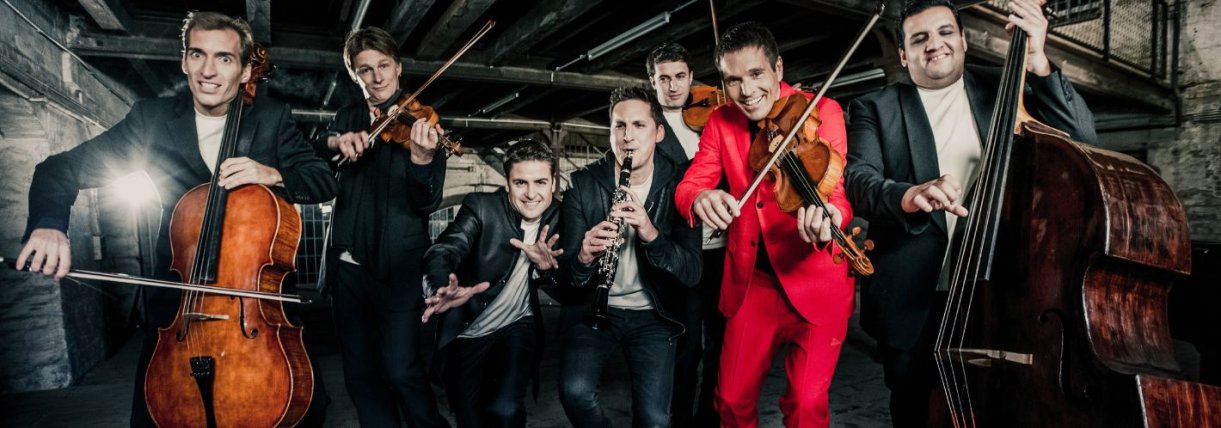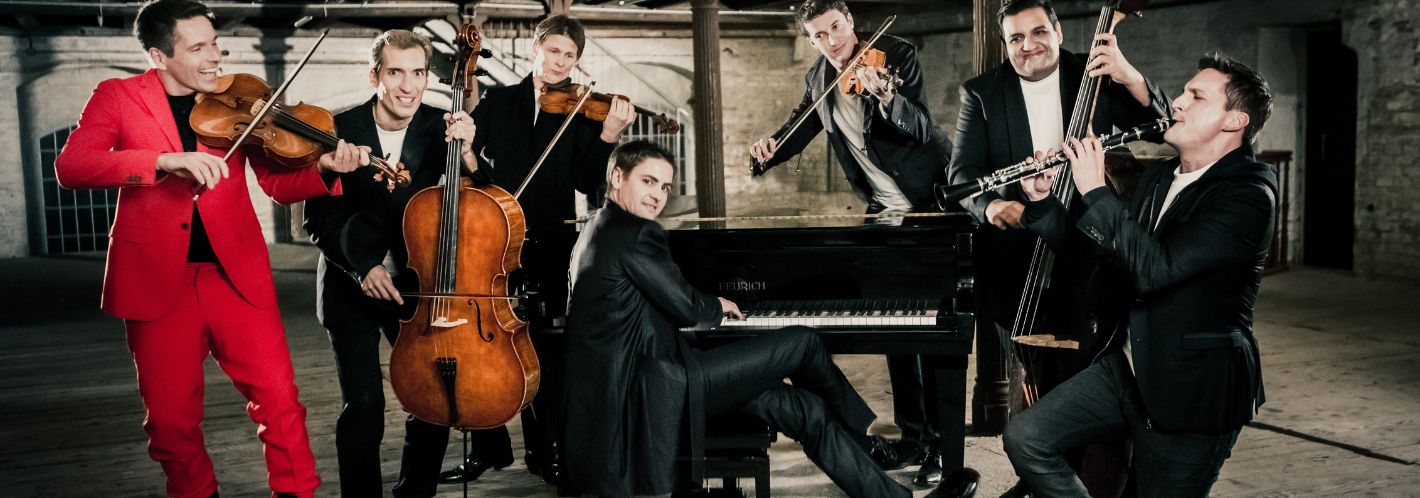
Antonín Dvořák: Humoresque No. 7 in G flat Major, Op. 101 (arr. by Stephan Koncz)
Maurice Ravel: La Valse (arr. by Stephan Koncz)
Sebastian Gürtler: Dichtungspolka
As the Philharmonix say, the rest of the programme is up in the air—guided by the audience’s energy and reactions.
Somewhere between a seven-piece band and a chamber ensemble, Philharmonix defy categorisation. They compose their own music but just as effortlessly borrow from Brahms, Sting, Satie, and Queen. The concert programme includes only the key repertoire. The musicians respond to the atmosphere of the hall, the energy of the audience, and their own mood, deciding what to play right there on stage. Their joy of music naturally turns into a spontaneous jam session, drawing in both their listeners and the performers themselves. The concert programme includes only the key repertoire. The musicians respond to the atmosphere of the hall, the energy of the audience, and their own mood, deciding what to play right there on stage. Their joy of music naturally turns into a spontaneous jam session, drawing in both their listeners and the performers themselves.They can play anything—and they’ve made it their mission to entertain. And yet, behind their playful energy lies the polished expertise of world-class musicians from the Berlin and Vienna Philharmonics, as well as soloists accustomed to the most prestigious concert halls.
For those who listen closely, their performance might feel like a compact symphonic concert—packed with incredible fun. But just as easily, they could be the ultimate café band, the kind you’d expect only at Vienna’s legendary Sacher Hotel. When they play with their orchestras, they record for the distinguished Deutsche Grammophon. But their own videos? Distributed by Vevo, just like those of Madonna and Lady Gaga.
For one night only, Philharmonix will transform the unconventional space of Divadlo X10 into a spectacular venue of pure entertainment—true to their motto: The Vienna Berlin Music Club.
Founded by members of the Berliner and Wiener Philharmoniker, the Philharmonix play everything they have always wanted to play. Their trademark: brilliant arrangements, incomparable virtuosity, and, above all, unbridled joy in making music together, which spills over to the listener in a matter of seconds.
In their brilliant new adaptations, they work on pop, jazz, swing, folk music, klezmer, and famous melodies from big Hollywood films in addition to classical works. They bring out previously unheard, original aspects to all compositions - and skilfully combine things that otherwise do not belong together. So not everything is classical music; but everything has musical class.
Their music is influenced by the sound aesthetics and tradition of the top orchestras for which they also work: Thilo Fechner (viola), Daniel Ottensamer (clarinet), and Ödön Rácz (double bass) play with the Wiener Philharmoniker; Stephan Koncz (cello) and Noah Bendix-Balgley (violin) with the Berliner Philharmoniker. They are joined by the outstanding soloists Christoph Traxler (piano) and Sebastian Gürtler (violin), who, together with Stephan Koncz, is also the compositional head of the ensemble. Their aspiration:
"The mind must rejoice, the heart exult, and the leg must twitch."
The ensemble records exclusively for Deutsche Grammophon and released their two albums The Vienna Berlin Music Club Vol. I and The Vienna Berlin Music Club Vol. II in 2018 and 2019. In September 2022, the third album The Vienna Berlin Music Club III was released. "Classical Music without Borders"—rarely has a category name been more fitting than in the case of the Philharmonix, who were awarded the OPUS KLASSIK award in 2018 for their first recording. The classical music expertise demonstrated by all members does not prove to be a barrier, but rather an inspiring door opener to new listening experiences.
The Philharmonix appear regularly at the Wiener Konzerthaus. Here they have held a subscription cycle in the Great Hall for several seasons, as well as at the Berliner Philharmonie, Tonhalle Düsseldorf, Kulturpalast Dresden, Philharmonie Essen, Philharmonie Luxembourg, and the Elbphilharmonie in Hamburg.
source: Konzertdirektion Schmid

The seven-story functionalist building was designed following the model of the German Werkbund as an administrative and exhibition centre for the Union of Czechoslovak Industry. This organisation played a key role in promoting Czechoslovak design and craftsmanship both at home and abroad.
The Union commissioned architect Oldřich Starý, a leading theorist of functionalism, chairman of the Architects’ Club, and editor-in-chief of the professional journal Stavba, to design the building. The project was created in 1934, and construction was completed in 1938.
The large basement hall, now home to Divadlo X10, was originally approved as a cinema with 718 seats but was instead used as an exhibition space for events showcasing applied arts and industrial design organised by the Union of Czechoslovak Works. Many prominent figures contributed to the programme and exhibitions, including Josef Gočár, Rudolf Stockar, and visual artists such as František Kysela and Vratislav Hugo Brunner.